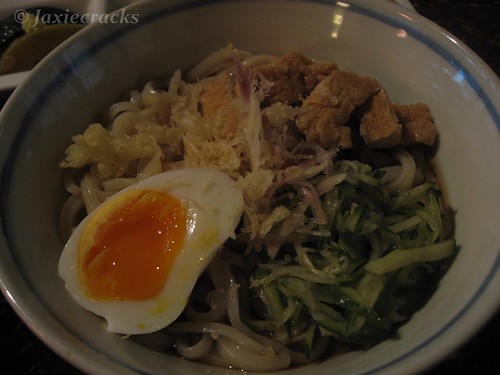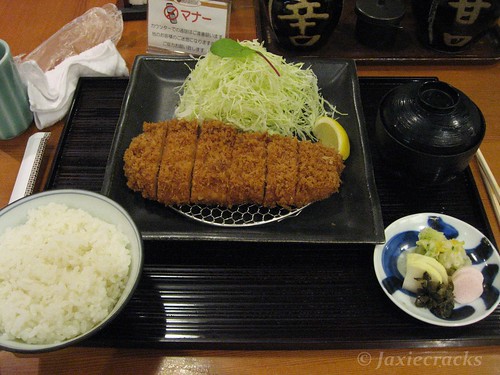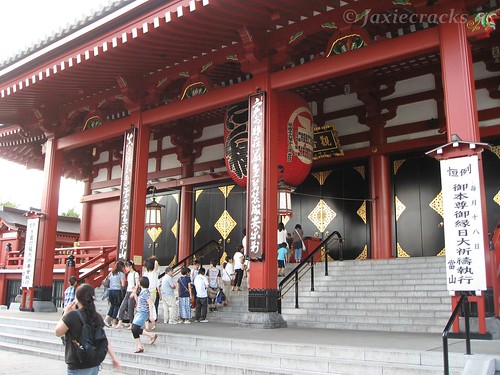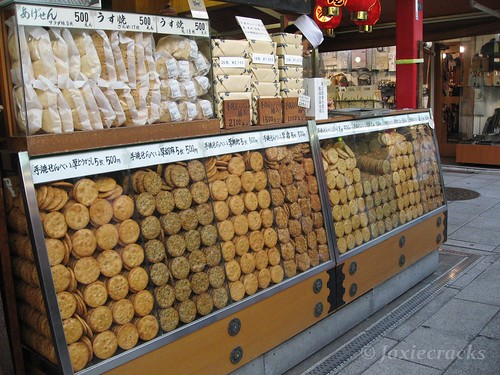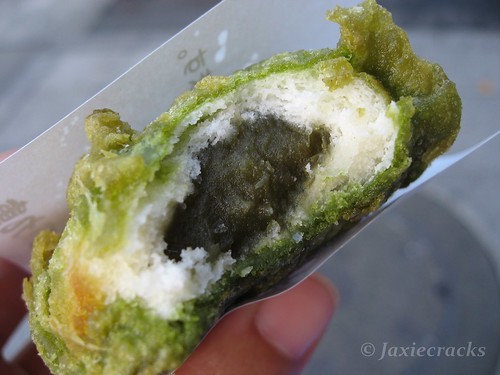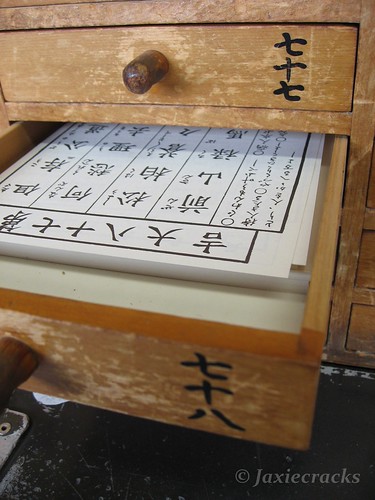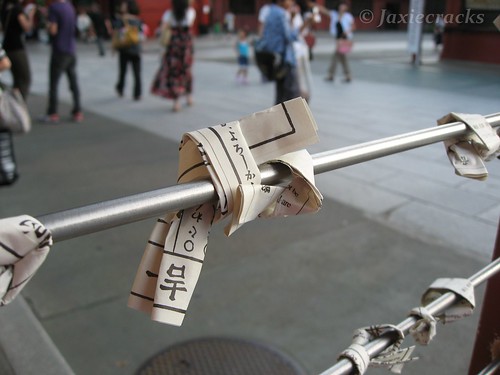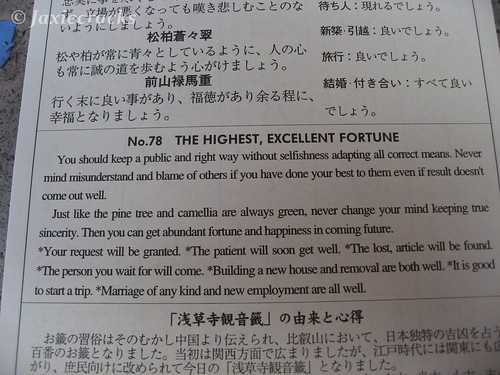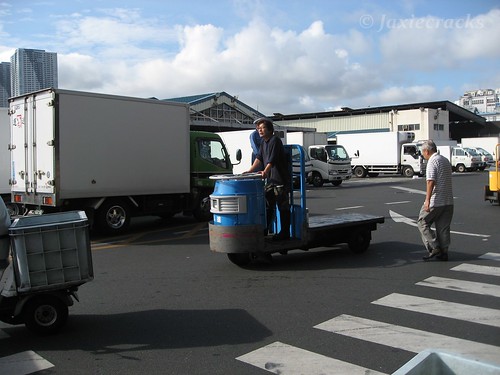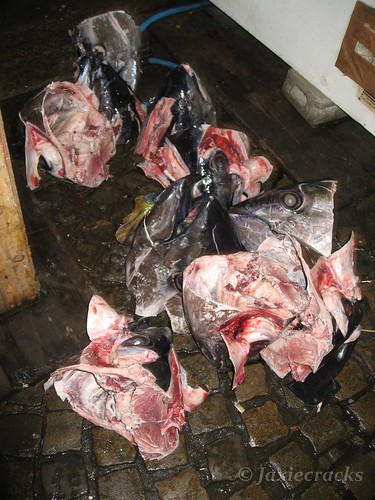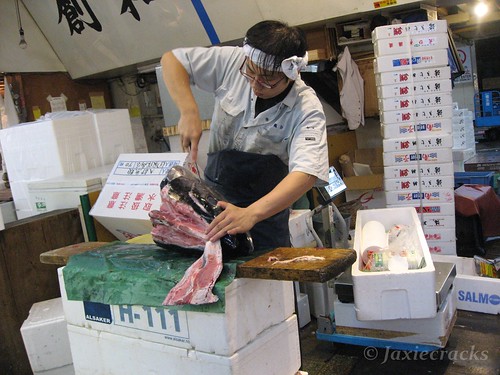Whew, who knew it could take so long for me to blog about 48 hours in Tokyo? But here I am finally finishing out my posts on my August trip. Clearly the two weeks in Hong Kong that preceded Tokyo will see this blog through the end of the year...
Just some bits and pieces that didn't quite fit in anywhere else or didn't seem to merit a full blog post on their own:
In-flight snack on ANA; I'll take this over stale pretzels and coke any day (thanks again for the deluxe air tickets Mom!)
A big part of the reason I was intimidated about navigating Tokyo on my own.
A manmade stream-like feature running through a park in Ropponggi where people can "rent" a seat:
Further along in the park, a tranquil scene at dusk:
A fairly delicious avocado and "Italian frozen yogurt" shake from the food basement of Mitsukoshi in Ginza. What made it "Italian", I don't know, but the attention to detail with the petite mint leaf tickled my fancy:
Lunch at a delicious Kyoto-style small plates place in the Nakameguro neighborhood. This place was tucked away from the street down a narrow little path with nary a sign (as far as I could tell) to indicate that it was even there. Definitely would never have found it on my own. Thanks for lunch Taro and Christine!
Cold udon was perfect for the 30+ degree Celsius weather
The history of Sensoji temple juxtaposed against the hypermodern Sky Tree broadcasting tower in the background
Cheerful mini-temple
Something about the way this bike was parked outside the restaurant and the black and white photo in the window made me think of an old Japanese film. Maybe channeling the quiet simplicity of an Ozu film?
All the guidebooks talked about the "salarymen" aka government workers who throng Tokyo's izakayas and bars after work. I have no idea if this crowd worked for the government, but this picture captures the faceless anonymity that that term always conjures in my head:
A big reason I was delighted to be navigating Tokyo on my own -- more tonkatsu for me!
This was at Maisen, a well-known tonkatsu establishment. Their special sauce totally made the meal -- none of that thick gloppy sweet stuff you squeeze out of a bottle.
This stuff was fresh, with I have no idea what inside it, but definitely had hints of fresh ginger and maybe even pineapple? I recommend dousing the tonkatsu with it to get that perfect bite:
All in all, not too shabby for a glorified layover methinks!
Showing posts with label Japan. Show all posts
Showing posts with label Japan. Show all posts
Thursday, September 22, 2011
Monday, September 12, 2011
Sensoji Temple and Carving Out Your Own Fortune
For some reason, Senso-ji, the major Buddhist temple in Tokyo, was closed when I visited it in early August.
Luckily, my visit to Asakusa, the neighborhood around Senso-ji, was not a complete waste. Not far from the temple is the kitchenwares district, with shops upon shops selling all sorts of food-related implements. Including those awesome plastic food models found outside many a restaurant. I was actually hoping to come away with some kind of plastic food as a souvenir (how cool would it be to have a bowl of udon on my desk, ALWAYS), but the prices seemed exorbitantly high for this unemployed vagabond (USD$20 for a keychain with a plasticized crepe at the end of it at one store!).
There is also a shopping street, the Nakamise, leading up to the temple that was bustling despite the temple’s closure.
In addition to the usual knickknack and souvenir stores selling fans, ninja costumes, and perpetually waving cats, were snack stands selling freshly made rice crackers:
I chose to indulge in a deep fried cake filled with a green tea paste:
Though I didn't get to actually enter the Senso-ji temple, I did participate in one of its popular rituals.
How to get your fortune told at Senso-ji temple:
(My favorite part is the warning at the end against being arrogant or fearful based on your fortune.)
Step 1: Shake the canister (politely!) while thinking of your wish.
[insert picture of tall hexagonal silver canister with a small hole at the top here. I tried to take a picture, but just couldn't get a good photograph out of it.]
[insert picture of tall hexagonal silver canister with a small hole at the top here. I tried to take a picture, but just couldn't get a good photograph out of it.]
Step 2: Note the number on the stick and find the corresponding drawer:
Step 3: Open the drawer to reveal your fortune:
If you get a bad fortune, you might want to do this so as to leave the bad luck behind:
But if you are destined for awesomeness, like me, and draw stick number 78, feel free to carry your fortune with you and go on to rock out in life. Of course, in case you have doubts about your proverb-interpretation skills, you can always consult the handy breakdown of what this all means in layman's terms at the bottom:
No matter what you draw, though, don't forget the final takeaway from those initial instructions: "You can carve out your own fortune."
Thursday, September 8, 2011
Sushi Breakfast at Tsukiji
Of course, no visit to Tsukiji is complete without a sushi breakfast (or so the guidebooks tell me). Although there are several places to eat in the outer market, two places in particular have become the “biggies” that attract all the attention.

This picture doesn’t quite do the crowds justice, as the line breaks off after a certain amount of people, and continues around the corner.
Finding places to eat while travelling can be an interesting process. On the one hand, you want good food, which usually means following some kind of recommendation, whether from friends, friends of friends, guidebooks, online forums, etc. Often a few places rise above the pack and end up getting repeated by everyone – which presumably ends up being a testament to the quality of the place. On the other hand, I often question the real value of going to said "must-visit" places. Is this place REALLY so much better than the others? I have this perpetual instinct to try to find the "undiscovered" gems instead, rather than following the previously trodden path of so many others. At a crossroads, I’ll sometimes err on the side of risking a bad experience for the opportunity to stumble on an undiscovered gem, rather than following the crowdsourced advice of "tried and true".
Thus I was of a mixed mind about where to eat. On the one hand, I only had 48 hours in Tokyo, and precious little time (and stomach space) to waste on a so-so meal. On the other hand, I had heard that most of the places in the market were of fairly comparable quality, which seemed to resonate with me. I mean, they’re all getting their fish (purportedly) from essentially the same source (i.e., 20 yards away) – what could make them so different anyway? Ever the bargain hunter, I decided to eschew the long lines in front of the “biggies” in favor of finding a less-touristy, potentially cheaper option.
The sushi bars must be in collusion, though, as there didn’t seem to be a cheaper option to be had. Apparently using lower prices to draw more customers in isn’t the practice here. Despite the fact that almost every sushi place, save the biggies, was practically empty, they pretty much offered the same options: various set menus starting around 2100 yen (at the time I was traveling, about USD$25-30) and up. Suddenly my options seemed to be 1. wait in line with everyone else to have the iconic experience at Daiwa Sushi or Sushi Dai, or 2. take my chances on one of the other places that seemed essentially deserted.
Overwhelmed with indecision (as I am wont to do), I finally ducked into Ryu Sushi (i.e., not one of the “biggies”) on a whim.
I wish I could say that my gamble paid off. I wish that I could tell you to head over to this place on your next trip to Japan, rather than those too popular for their own good biggies. I wish I could say that the sushi set I ate made me feel like I had died and gone to heaven, and included the freshest fish I had ever tasted. Lord knows that’s the prescribed formula for most travel writing.
Like the time I got a free “student” haircut and ended up with much too short bangs instead of shelling out the cash for a real live professional stylist (now that I think about it, actually, I’ve done that twice…), however, my sushi experience was only kind of so-so. Truth be told, aside from the novelty of being in Japan, at Tsukiji, and not entirely able to communicate with my restaurant staff, the sushi I ate was fairly forgettable. While undoubtedly fresh (as in, I couldn’t smell anything off about it), most of the fish I ate was distinctly tough and chewy. Not the end-all, be-all of sushi eating that I had heard legends about.
Surprisingly, the most enjoyable parts of my breakfast involved eating things that I don't normally enjoy eating. Like eel.
Whether sliced in rounds and steamed with some soy sauce and ginger, or lathered with sauce and broiled in the form of unagi, I just don't like the texture or the taste of that snakelike sea creature. And yet the eel here was (here’s the travel writing formula kicking in again, though I say this without any exaggeration) a revelation to me. It melted in my mouth with just a hint of sweetness from its accompanying sauce, something slightly thicker and sweeter than soy, but definitely not the usual unagi iteration.
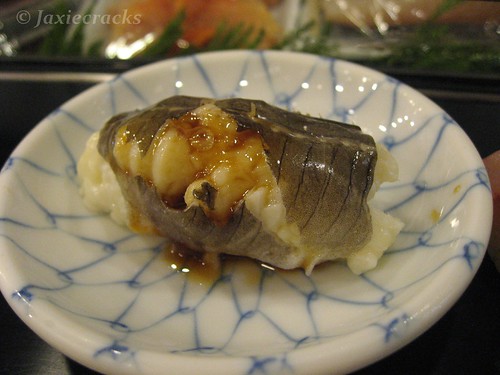

This picture doesn’t quite do the crowds justice, as the line breaks off after a certain amount of people, and continues around the corner.
Finding places to eat while travelling can be an interesting process. On the one hand, you want good food, which usually means following some kind of recommendation, whether from friends, friends of friends, guidebooks, online forums, etc. Often a few places rise above the pack and end up getting repeated by everyone – which presumably ends up being a testament to the quality of the place. On the other hand, I often question the real value of going to said "must-visit" places. Is this place REALLY so much better than the others? I have this perpetual instinct to try to find the "undiscovered" gems instead, rather than following the previously trodden path of so many others. At a crossroads, I’ll sometimes err on the side of risking a bad experience for the opportunity to stumble on an undiscovered gem, rather than following the crowdsourced advice of "tried and true".
Thus I was of a mixed mind about where to eat. On the one hand, I only had 48 hours in Tokyo, and precious little time (and stomach space) to waste on a so-so meal. On the other hand, I had heard that most of the places in the market were of fairly comparable quality, which seemed to resonate with me. I mean, they’re all getting their fish (purportedly) from essentially the same source (i.e., 20 yards away) – what could make them so different anyway? Ever the bargain hunter, I decided to eschew the long lines in front of the “biggies” in favor of finding a less-touristy, potentially cheaper option.
The sushi bars must be in collusion, though, as there didn’t seem to be a cheaper option to be had. Apparently using lower prices to draw more customers in isn’t the practice here. Despite the fact that almost every sushi place, save the biggies, was practically empty, they pretty much offered the same options: various set menus starting around 2100 yen (at the time I was traveling, about USD$25-30) and up. Suddenly my options seemed to be 1. wait in line with everyone else to have the iconic experience at Daiwa Sushi or Sushi Dai, or 2. take my chances on one of the other places that seemed essentially deserted.
Overwhelmed with indecision (as I am wont to do), I finally ducked into Ryu Sushi (i.e., not one of the “biggies”) on a whim.
I wish I could say that my gamble paid off. I wish that I could tell you to head over to this place on your next trip to Japan, rather than those too popular for their own good biggies. I wish I could say that the sushi set I ate made me feel like I had died and gone to heaven, and included the freshest fish I had ever tasted. Lord knows that’s the prescribed formula for most travel writing.
Like the time I got a free “student” haircut and ended up with much too short bangs instead of shelling out the cash for a real live professional stylist (now that I think about it, actually, I’ve done that twice…), however, my sushi experience was only kind of so-so. Truth be told, aside from the novelty of being in Japan, at Tsukiji, and not entirely able to communicate with my restaurant staff, the sushi I ate was fairly forgettable. While undoubtedly fresh (as in, I couldn’t smell anything off about it), most of the fish I ate was distinctly tough and chewy. Not the end-all, be-all of sushi eating that I had heard legends about.
Surprisingly, the most enjoyable parts of my breakfast involved eating things that I don't normally enjoy eating. Like eel.
Whether sliced in rounds and steamed with some soy sauce and ginger, or lathered with sauce and broiled in the form of unagi, I just don't like the texture or the taste of that snakelike sea creature. And yet the eel here was (here’s the travel writing formula kicking in again, though I say this without any exaggeration) a revelation to me. It melted in my mouth with just a hint of sweetness from its accompanying sauce, something slightly thicker and sweeter than soy, but definitely not the usual unagi iteration.

I was taken aback to have actually liked an eel dish. Just to be sure I was actually eating eel, I pointed to the empty dish, then made an undulating motion with my hand. Drawing upon my memory of those visual placards found at almost every sushi restaurant in the States outlining sushi types and their names, I tried to remember the word for eel.
“Ana?” I asked.
“-go” the sushi chef responded, nodding. I had left off a crucial last syllable, but had essentially identified my breakfast species correctly. Who knew that I could like eel?
Wasabi is another thing I can generally do without while eating sushi. Part of that comes from my relatively low tolerance for spicy things. Though, as I've gotten older, and especially in more recent years, I've been starting to enjoy more spicy foods, recognizing that they impart something more than just heat on the tongue, watery eyes and cleared sinuses. I'll usually just put a small dab of wasabi in my soy sauce dish (for some reason it just looks odd to me without the wasabi. Childish, even), and give it a little swirl, though I do cop to swiping off the wasabi-tainted rice that sneaks into my nigiri.
The wasabi at this sushi bar came from a fresh wasabi root, however. Unlike with the industrially produced, reconstituted green paste that one usually associates with sushi, eating this wasabi was like discovering a new side of the sushi world. Though I've had fresh wasabi before, it hadn't been the revelation for me then that it was here. I don’t quite know how to articulate it, but this wasabi was complex and layered, with flavor and piquancy hitting at different parts of my mouth in contrast to the simple, smooth, straightforward sashimi. I was tasting several different things at once, not just a mustardy spiciness that shoots up your nose. For the first time in my life, I actually appreciated wasabi.
After finishing my meal at Ryu Sushi and feeling full but not impressed, I did (and still do) wonder if I should have bit the bullet and waited in line with the other tourists for the iconic Sushi Dai or Daiwa Sushi experience. I’ve seen and read various reports by friends that indicated that it was well-worth the experience, and perhaps I missed out on an amazing, life-changing meal. Then again, what’s the fun of travelling if not to take some risks and make your own path, for better or for worse? No regrets, just more reasons to go back.
Friday, August 26, 2011
Tsukiji Fish Market
*For those people who find images of carved fish heads and bodies disturbing, please note that such images occur within this post.
Almost every account aimed at educating tourists about the famed Tsukiji fish market in Tokyo will tell you that the key to a successful visit involves waking up well before the sun rises. The fish and seafood actually start arriving from all over the world before the previous day has ended, and by 5 am the wheeling and dealing is in full swing. This is what most people come to Tsukiji to experience: a glimpse into the nexus of a multi-billion dollar industry unlike any other.
Many of the write-ups, however, also mention how a 2008 incident involving a tourist allegedly licking a tuna head has made what were already wary employees even more disdainful of the unanticipated and unwritten addition of "tourist attraction" to their business cards. As the always considerate, always respectful traveler, and appropriately scared off by warnings that the people who do the real business in Tsukiji hate bumbling tourists getting in their way and taking pictures willy-nilly, I early on decide not to attempt to navigate the wholesale auction aspect of this behemoth. Instead, I reason that I can save the early morning taxi fare (new procedures have tourists lining up hours before the subway trains start running), abstain from participating in the depletion of the world’s stock of tuna, and still soak in the atmosphere of the more tourist-friendly outer market.
After a few delays thanks to the snooze button, I finally drag myself out of bed, hating, as usual, the feeling of having to wake up while it is still dark outside. In this part of the world, however, the sun rises early, and despite the cloaked-in, wee hours of the morning feeling of my hotel room, I draw open the curtains to see that it is full daylight outside.
Or perhaps I simply don’t get up at 6 am enough to realize that this is the norm in the summer, regardless of geographical location.
When I arrive at Tsukiji, I’m immediately thrown for a loop. Thinking that I had missed the height of the wholesale chaos, I nonetheless encounter an endless stream of trucks, mechanized trolleys aka "turret trucks", and scooters that seem destined to mow me down at some point. I can hardly figure out where one is supposed to go, and blindly walk in what seems to be the direction of the center of activity.
As I try to make sense of my surroundings, I find myself in the outer market area where auxiliary businesses support the main business of the fish traders: stalls selling all manner of knives, tubs of assorted pickled vegetables, bins upon bins of bonito flakes, ceramicware ranging from the intricately detailed to straightforwardly functional, thick logs of tamago (egg cakes), and, of course, a host of sushi purveyors. I weave through the pathways of this more familiar, consumer rather than wholesale setting, and begin to feel calmer, less overwhelmed, and more able to keep my wits about me.
By the time I have explored every nook and cranny of the outer market and filled my belly with a sushi breakfast, I feel reasonably satisfied with my visit, notwithstanding the fact that I have yet to actually see where the real business of Tsukiji takes place. As I walk around considering where to go next, however, I see some tourist-looking people headed towards a large building. In one of the few instances of finding comfort in the presence of other tourists in the context of traveling abroad (as opposed to that, "Oh, man, you're here too?" feeling), I reason that they must know where they are going, and that there is some shielding from the wrath of angry fishmongers to be found in sticking with other tourists. So I take advantage of a momentary lapse in the steady stream of traffic that still surrounds the market, and with the help of TWO crossing guards, finally find myself in the main seafood market.
There's a definite buzz going on, but as I pick my way through puddles and dodge temporary styrofoam aquariums, I come to realize that I have inserted myself into something less than a full-fledged business trading floor. I also learn that if you want to fit in to this place, the key is to invest in some rubber boots.
At around 9:30 in the morning, the height of the activity has long since diminished, but there are still a few hours to go before the market fully shuts down for its daily top-to-bottom cleaning, replete sprinkler trucks. Though the main attraction of Tsukiji is the bluefin tuna auction drawing buyers and sellers from around the world (though most of the fish ends up in regional restaurants), I find a certain magic in this winding down time, in limbo between the real business of the day and the full-shutdown of the market. The wholesalers are standing around, or visiting each other’s stands, and I feel like I am granted a glimpse into the underlying camaraderie that must maintain the social networks of this place above and beyond the wheeling and dealing. A gray-haired gentleman leans in closely as a younger protege slices through a massive hunk of deep red tuna with careful deliberation. Others walk a U-shaped pattern, coming down the narrow walkway between the freezers and trays in front of their stall, briefly joining the public path, then turning to walk up to another stall to greet their friends, competitors, and colleagues with a handshake and perhaps a word on how their accounts went in the hours prior. There is still some business to be had, tourists or other regular consumers taking their bounty away in bags rather than crates or order slips, but for the most part, this seems to be a window of time dedicated more to socializing than to transactions. Not only do I feel distinctly outside of these exclusive social circles, I am also acutely aware of my status as one of the few females in what is clearly a male-dominated industry. Rather than globalized trade routes or international commodities, I think of sociology studies, of the inherent fraternal nature of this place and the business it supports.
Interestingly, this fraternal socialization thrives even amongst the vaguely abattoir setting of a wholesale fresh (and freshly killed) seafood warehouse. There is good reason for the ubiquitous rubber footwear worn by those in the know: against the dark floor, it is difficult to discern spilt water from spilt fish blood. While I am an unabashed omnivore, and reasonably accustomed to confronting the realities of living at the top of the food chain, I find the constant reminders of death intriguing, a candid mix of mortality, the moribund, and the morbid all together. A few styrofoam containers appear stained with a deep garnet hue, while others hold more explicit deep sea entrails. Turret trucks neatly cart off open tubs of fish carcasses, while mounds of fish heads patiently await their due processing on the ground.
I come across a lone fish cutter, hacking away at a giant head. The presence of a few other tourists gathered around him makes me think that taking a picture would be okay, and with my flash turned off, I quickly do so.
Then another man comes up to the fish cutter, says something in Japanese, and they both glance in my direction. "Shit," I think, "so much for being the considerate and respectful traveler." The fish cutter gives a shrug, though, and continues about his business. I've been let off the proverbial hook, it seems, though I wouldn't be surprised if I was unwittingly the subject of some bad words in Japanese.
Though I still would not recommend this place for the squeamish, there is actually a greater sense of sanitization amongst the refuse here than in some of the wet markets that I've walked through in Hong Kong. Perhaps this comes from my knowing that the market completely shuts down every day for the sole purpose of cleaning. Or maybe it is just that, unlike those markets that I visit during regular business hours, here I am seeing people in the active business of cleaning up following a day of work, methodically soaping up and hosing down their stations. I was struck in particular with one stall that had long since packed up for the day. At the very front of the stall, carefully laid out on a wooden chopping block were, literally, the tools of trade. All sorts of knives of varying lengths and sizes, lined up with such precision one might think that Her Majesty the Queen's butlers had stopped by with their rulers. Taken by the latent sense of non-ostentatious pride in the display, this time I seek permission before taking out my camera. Mobilizing my limited Japanese language skills, I tentatively call out to the man smoking at the back of the stall.
"Sumimasen?" I mime taking a picture of the knives.
He doesn't respond at first, and I think, "Shit, I'm that horrible tourist they hate." But then he nods, and without a word or a smile, flicks on the lamps that hang directly over my subject before leaving me to my business. I quickly snap a few photos, and then, having already used up most of my Japanese skills, draw upon the dregs of my vocabulary. "Domoarigato," I say as I do a sort of odd, uncertain bow, which seems both appropriate and totally out of place at the same time. He just nods, cool as a cucumber, and descends to re-extinguish the lamps.
I finally leave the place in awe of some of the amazing things I’ve seen. But I also leave with a conflicted sense of this place’s status as a “must-see” tourist destination in Tokyo. In tourism studies speak, the Tsukiji fish market presents a blurring of the front- and back-stage areas of tourism performance. The massive scale of trade that goes on in this place has made it an international tourist destination. And yet, what makes this place more touristic or less a workplace than any other wholesale distribution warehouse on the outskirts of a major city? What makes these fish tradesmen more “performers” than their lesser photographed and visited counterparts on the docks of New York or outskirts of Paris?
A wholesale food distribution warehouse is right up my alley as an interesting diversion, a distinctive experience, and an opportunity to better understand our food supply chain. But I also sympathize with those Tsukiji employees who find the due course of their business impinged on by people looking for something new and novel, people who see a place of work as a playground for leisure, rather than as a livelihood. Perhaps, though, this all reflects the general theme of globalization that underlies modern tourism and trade. Just as globalization renders geo-political borders subservient to commerce and money, the barriers between everyday life, tourism, and performance get blurred as well.
Almost every account aimed at educating tourists about the famed Tsukiji fish market in Tokyo will tell you that the key to a successful visit involves waking up well before the sun rises. The fish and seafood actually start arriving from all over the world before the previous day has ended, and by 5 am the wheeling and dealing is in full swing. This is what most people come to Tsukiji to experience: a glimpse into the nexus of a multi-billion dollar industry unlike any other.
Many of the write-ups, however, also mention how a 2008 incident involving a tourist allegedly licking a tuna head has made what were already wary employees even more disdainful of the unanticipated and unwritten addition of "tourist attraction" to their business cards. As the always considerate, always respectful traveler, and appropriately scared off by warnings that the people who do the real business in Tsukiji hate bumbling tourists getting in their way and taking pictures willy-nilly, I early on decide not to attempt to navigate the wholesale auction aspect of this behemoth. Instead, I reason that I can save the early morning taxi fare (new procedures have tourists lining up hours before the subway trains start running), abstain from participating in the depletion of the world’s stock of tuna, and still soak in the atmosphere of the more tourist-friendly outer market.
After a few delays thanks to the snooze button, I finally drag myself out of bed, hating, as usual, the feeling of having to wake up while it is still dark outside. In this part of the world, however, the sun rises early, and despite the cloaked-in, wee hours of the morning feeling of my hotel room, I draw open the curtains to see that it is full daylight outside.
Or perhaps I simply don’t get up at 6 am enough to realize that this is the norm in the summer, regardless of geographical location.
When I arrive at Tsukiji, I’m immediately thrown for a loop. Thinking that I had missed the height of the wholesale chaos, I nonetheless encounter an endless stream of trucks, mechanized trolleys aka "turret trucks", and scooters that seem destined to mow me down at some point. I can hardly figure out where one is supposed to go, and blindly walk in what seems to be the direction of the center of activity.
As I try to make sense of my surroundings, I find myself in the outer market area where auxiliary businesses support the main business of the fish traders: stalls selling all manner of knives, tubs of assorted pickled vegetables, bins upon bins of bonito flakes, ceramicware ranging from the intricately detailed to straightforwardly functional, thick logs of tamago (egg cakes), and, of course, a host of sushi purveyors. I weave through the pathways of this more familiar, consumer rather than wholesale setting, and begin to feel calmer, less overwhelmed, and more able to keep my wits about me.
By the time I have explored every nook and cranny of the outer market and filled my belly with a sushi breakfast, I feel reasonably satisfied with my visit, notwithstanding the fact that I have yet to actually see where the real business of Tsukiji takes place. As I walk around considering where to go next, however, I see some tourist-looking people headed towards a large building. In one of the few instances of finding comfort in the presence of other tourists in the context of traveling abroad (as opposed to that, "Oh, man, you're here too?" feeling), I reason that they must know where they are going, and that there is some shielding from the wrath of angry fishmongers to be found in sticking with other tourists. So I take advantage of a momentary lapse in the steady stream of traffic that still surrounds the market, and with the help of TWO crossing guards, finally find myself in the main seafood market.
There's a definite buzz going on, but as I pick my way through puddles and dodge temporary styrofoam aquariums, I come to realize that I have inserted myself into something less than a full-fledged business trading floor. I also learn that if you want to fit in to this place, the key is to invest in some rubber boots.
At around 9:30 in the morning, the height of the activity has long since diminished, but there are still a few hours to go before the market fully shuts down for its daily top-to-bottom cleaning, replete sprinkler trucks. Though the main attraction of Tsukiji is the bluefin tuna auction drawing buyers and sellers from around the world (though most of the fish ends up in regional restaurants), I find a certain magic in this winding down time, in limbo between the real business of the day and the full-shutdown of the market. The wholesalers are standing around, or visiting each other’s stands, and I feel like I am granted a glimpse into the underlying camaraderie that must maintain the social networks of this place above and beyond the wheeling and dealing. A gray-haired gentleman leans in closely as a younger protege slices through a massive hunk of deep red tuna with careful deliberation. Others walk a U-shaped pattern, coming down the narrow walkway between the freezers and trays in front of their stall, briefly joining the public path, then turning to walk up to another stall to greet their friends, competitors, and colleagues with a handshake and perhaps a word on how their accounts went in the hours prior. There is still some business to be had, tourists or other regular consumers taking their bounty away in bags rather than crates or order slips, but for the most part, this seems to be a window of time dedicated more to socializing than to transactions. Not only do I feel distinctly outside of these exclusive social circles, I am also acutely aware of my status as one of the few females in what is clearly a male-dominated industry. Rather than globalized trade routes or international commodities, I think of sociology studies, of the inherent fraternal nature of this place and the business it supports.
Interestingly, this fraternal socialization thrives even amongst the vaguely abattoir setting of a wholesale fresh (and freshly killed) seafood warehouse. There is good reason for the ubiquitous rubber footwear worn by those in the know: against the dark floor, it is difficult to discern spilt water from spilt fish blood. While I am an unabashed omnivore, and reasonably accustomed to confronting the realities of living at the top of the food chain, I find the constant reminders of death intriguing, a candid mix of mortality, the moribund, and the morbid all together. A few styrofoam containers appear stained with a deep garnet hue, while others hold more explicit deep sea entrails. Turret trucks neatly cart off open tubs of fish carcasses, while mounds of fish heads patiently await their due processing on the ground.
I come across a lone fish cutter, hacking away at a giant head. The presence of a few other tourists gathered around him makes me think that taking a picture would be okay, and with my flash turned off, I quickly do so.
Then another man comes up to the fish cutter, says something in Japanese, and they both glance in my direction. "Shit," I think, "so much for being the considerate and respectful traveler." The fish cutter gives a shrug, though, and continues about his business. I've been let off the proverbial hook, it seems, though I wouldn't be surprised if I was unwittingly the subject of some bad words in Japanese.
Though I still would not recommend this place for the squeamish, there is actually a greater sense of sanitization amongst the refuse here than in some of the wet markets that I've walked through in Hong Kong. Perhaps this comes from my knowing that the market completely shuts down every day for the sole purpose of cleaning. Or maybe it is just that, unlike those markets that I visit during regular business hours, here I am seeing people in the active business of cleaning up following a day of work, methodically soaping up and hosing down their stations. I was struck in particular with one stall that had long since packed up for the day. At the very front of the stall, carefully laid out on a wooden chopping block were, literally, the tools of trade. All sorts of knives of varying lengths and sizes, lined up with such precision one might think that Her Majesty the Queen's butlers had stopped by with their rulers. Taken by the latent sense of non-ostentatious pride in the display, this time I seek permission before taking out my camera. Mobilizing my limited Japanese language skills, I tentatively call out to the man smoking at the back of the stall.
"Sumimasen?" I mime taking a picture of the knives.
He doesn't respond at first, and I think, "Shit, I'm that horrible tourist they hate." But then he nods, and without a word or a smile, flicks on the lamps that hang directly over my subject before leaving me to my business. I quickly snap a few photos, and then, having already used up most of my Japanese skills, draw upon the dregs of my vocabulary. "Domoarigato," I say as I do a sort of odd, uncertain bow, which seems both appropriate and totally out of place at the same time. He just nods, cool as a cucumber, and descends to re-extinguish the lamps.
I finally leave the place in awe of some of the amazing things I’ve seen. But I also leave with a conflicted sense of this place’s status as a “must-see” tourist destination in Tokyo. In tourism studies speak, the Tsukiji fish market presents a blurring of the front- and back-stage areas of tourism performance. The massive scale of trade that goes on in this place has made it an international tourist destination. And yet, what makes this place more touristic or less a workplace than any other wholesale distribution warehouse on the outskirts of a major city? What makes these fish tradesmen more “performers” than their lesser photographed and visited counterparts on the docks of New York or outskirts of Paris?
A wholesale food distribution warehouse is right up my alley as an interesting diversion, a distinctive experience, and an opportunity to better understand our food supply chain. But I also sympathize with those Tsukiji employees who find the due course of their business impinged on by people looking for something new and novel, people who see a place of work as a playground for leisure, rather than as a livelihood. Perhaps, though, this all reflects the general theme of globalization that underlies modern tourism and trade. Just as globalization renders geo-political borders subservient to commerce and money, the barriers between everyday life, tourism, and performance get blurred as well.
Subscribe to:
Posts (Atom)







